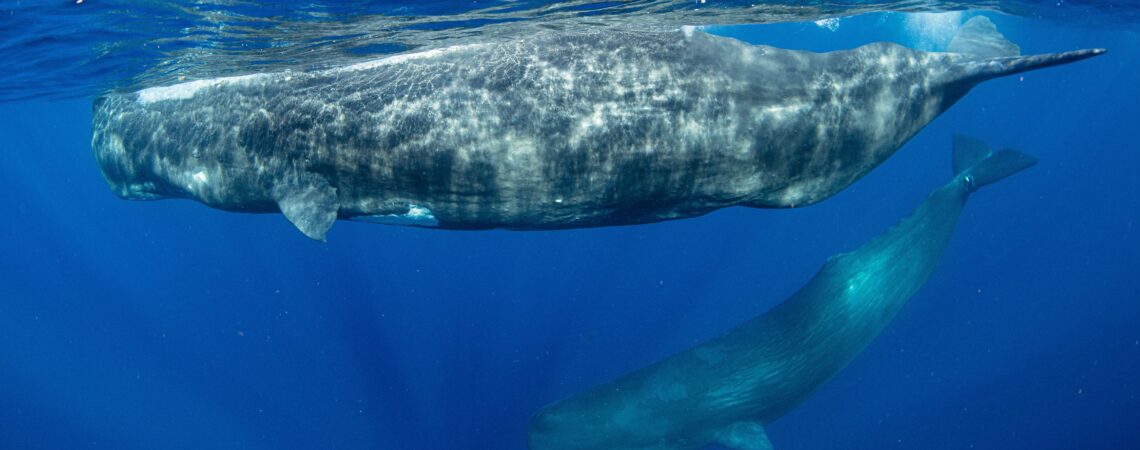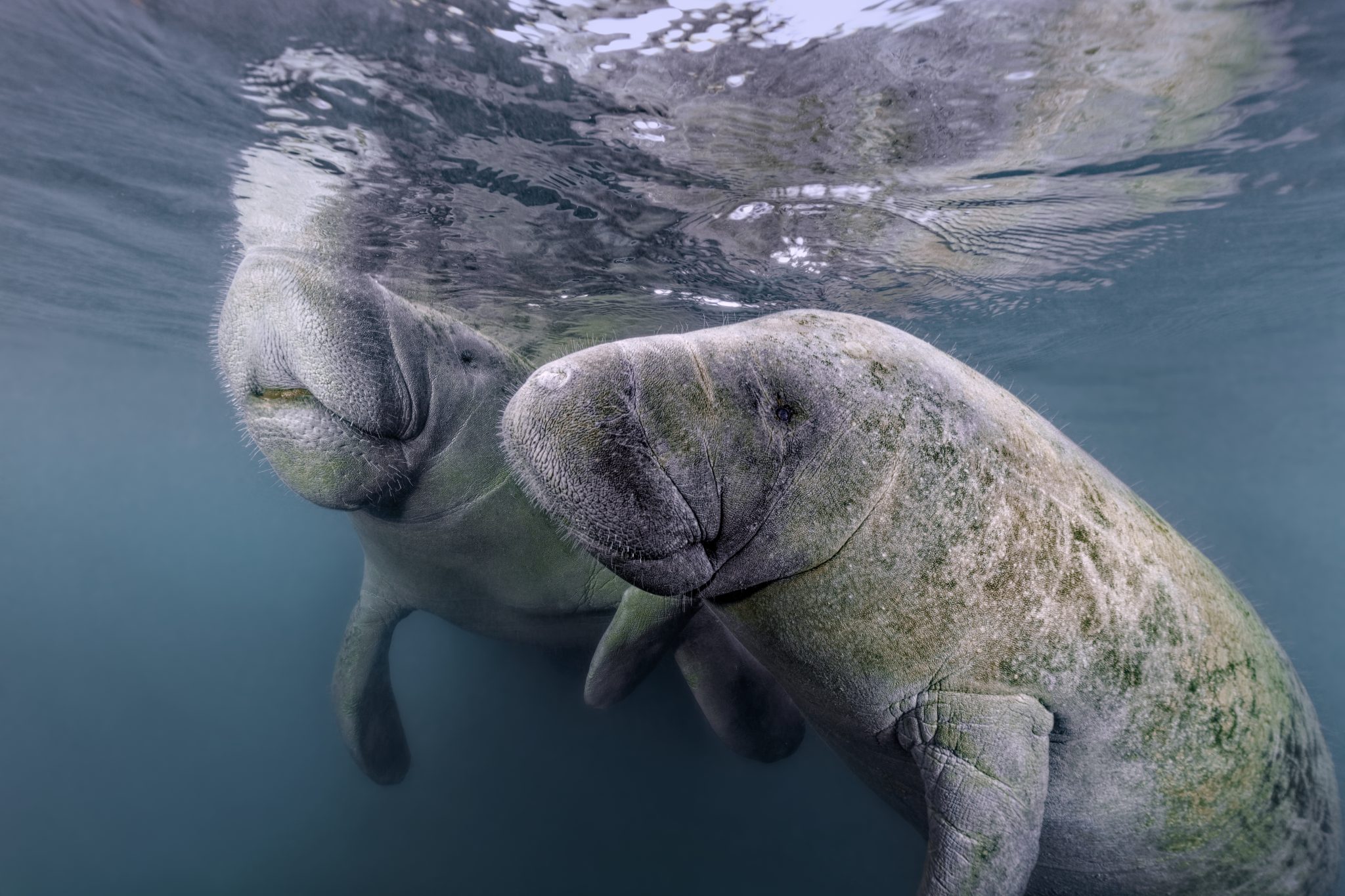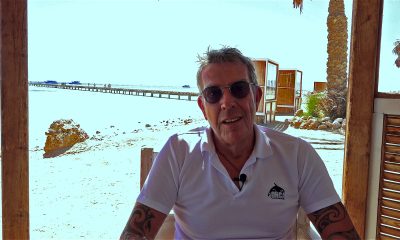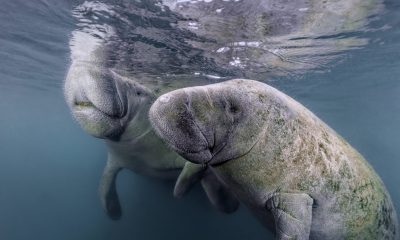Marine Life & Conservation
Dominica Establishes World’s First Sperm Whale Reserve, a Boost for Climate, Biodiversity and the Local Economy

Protecting the country’s whales sequesters as much carbon as taking 5,000 cars off the road every year – it also bolsters the local economy and paves the way for other countries to safeguard this at-risk species elsewhere.
The government of Dominica announced its commitment to establish a Sperm Whale Reserve off the Caribbean (western) side of the Island nation. The new reserve will help sequester carbon and generate tourism income while also protecting a species under increased threat from human activity. Scientists involved in its planning and establishment assert that protection of almost 800 square kilometers will deliver benefits from the local to the global.
Sperm whales have the largest brains on earth, matrilineal societies, and a complex language. They are the largest-toothed predator on our planet, with males on average 16 meters (52 ft) long – bigger than a school bus. Sperm whales are found in waters worldwide – from Iceland to New Zealand. But Dominica is one of the few countries in the world where sperm whales can be seen consistently throughout the year. Dominica offers a unique habitat where a resident population of sperm whales finds food and shelter, making the west coast of the island critical feeding and nursing grounds.
“The 200 or so sperm whales that call our sea home are prized citizens of Dominica,” said Dominica’s Prime Minister Roosevelt Skerrit. “Their ancestors likely inhabited Dominica before humans arrived. We want to ensure these majestic and highly intelligent animals are safe from harm and continue keeping our waters and our climate healthy. Dominica is honored to establish the first Sperm Whale Reserve on our planet.”
Once the 788 square-kilometer reserve is established, a “Senior Whale Officer” and observers stationed to tourism and research vessels will oversee and reinforce the expanded whale tourism regulations. Sustainable artisanal fishing, which does not interfere with the sperm whales’ behavior or compete with them for food, will be permitted. Visitors to Dominica will have the opportunity to swim with these whales or view them from a boat, but they will do so in more sustainable numbers and under new strict regulations, to ensure that the sperm whales and other species of whales and dolphins aren’t disturbed.
Overlooked Climate Benefits
“Protecting these whales offers an incredible, cost-effective climate solution that has been overlooked by policymakers,” said Enric Sala, the founder of Pristine Seas and an Explorer in Residence at National Geographic. “By protecting sperm whales, Dominica is bolstering its climate resilience. The more sperm whales in Dominica’s waters, the more carbon sequestered in the deep sea, thus helping to mitigate global warming.” Sala has been advising the government of Dominica on the establishment of the reserve.
Whale feces are particularly climate-friendly. Sperm whales dive between 650-1000 meters deep to hunt squid. When they are at the surface between dives, they breathe, rest and defecate. Their nutrient-rich feces – with iron concentrations 10 million times greater than the surrounding water at the surface – foster plankton blooms which capture carbon dioxide from seawater. When the plankton dies, it sinks to the deep sea with the carbon in it, thus becoming a carbon sink and helping to mitigate the impacts of global warming.
Based on a study of carbon sequestration by sperm whales elsewhere, and assuming 250 sperm whales currently in Dominica’s waters, Sala estimated that these whales could sequester 4200 metric tonnes of carbon every year – equivalent to the carbon sequestered by 18,000 acres of U.S. forests in one year.
Sperm Whales Under Threat
“The community of sperm whales which use the waters off Dominica are at risk,” said Dr. Shane Gero, National Geographic Explorer, Founder of The Dominica Sperm Whale Project and also Lead Biologist for Project CETI, who was a scientific advisor on the establishment of the reserve. “These ‘island whales’ live alongside humans, preferring this island over others, making our actions in their ocean home their biggest threat. These whales are entangled in fishing gear, ingest our plastic trash that washes into the sea, engulfed in our noise which radiates deep into the ocean where they hunt for squid, and are hit by ships, a particularly heightened threat in the Caribbean, where everything is imported and many vessels transit between islands. All of this comes together to paint a distressing picture for the future of sperm whales.”
Between 2005 and 2015, the numbers of sperm whales in the 12 most-studied families off Dominica have shown a steady decline, seemingly caused by a substantial drop in survival starting in about 2008. If overall trends continue, by 2030 there will be very few animals left.
A Conservation Business Plan
The Reserve will cover less than three percent of Dominica’s waters, which offers enough protection for the sperm whales. Restricting ships to only use designated corridors has been proven to not only reduce the risk of ship strikes and noise in an area sperm whales use for feeding and nursing, but it also reduces the risk of fishing gear being broken by large ships, which in turn protects the whales from entanglement and reduces replacement costs to fishers. A win-win.
“Dominica has the opportunity to show the world how to reconcile marine conservation with responsible use of the sea. A well-designed and regulated whale tourism operation can bring in economic revenue to offset the direct costs of managing and enforcing the reserve – and bring additional benefits to Dominica’s people,” said Kristin Rechberger, the CEO of Dynamic Planet, which advised Dominica on the economic aspects of the reserve. “With a proper conservation business plan, protecting nature is achievable by all countries, large and small.”
For more information about Pristine Seas, visit www.nationalgeographic.org/society/our-programs/pristine-seas/
Photo: Enric Sala/National Geographic Pristine Seas
Blogs
Heading out on the water this Summer? Watch for manatees

As National Safe Boating Week approaches, Save the Manatee® Club is urging boaters, and anyone that enjoys Florida’s waterways, to respect and protect the defenseless manatees that inhabit our shared waterways. From May 18 to 24, leading up to Memorial Day Weekend, the campaign aims to raise awareness about recreational boating safety and the importance of safeguarding imperiled manatees during the summer boating season. This week also emphasizes the importance of encouraging boaters to enroll in a boating safety course.
Manatees are semi-migratory marine mammals that are commonly found in shallow estuaries, bays, rivers, canals, and coastal areas throughout Florida and neighboring states. With some manatees venturing as far west as Texas and as far north as Massachusetts, collisions between these gentle giants and watercraft have become distressingly frequent. Boat propellers and high-speed collisions pose significant threats to manatees, often resulting in severe injuries or even death.
Save the Manatee Club is calling on all water enthusiasts to follow essential manatee safety tips to ensure the well-being of the imperiled manatee:
- Obey Speed Zone Signs: Familiarize yourself with and adhere to posted speed limits to prevent collisions with manatees.
- Reduce Glare with Polarized Sunglasses: Wear polarized sunglasses to enhance visibility and spot manatees below the water’s surface.
- Recognize Manatee Signs: Learn to identify signs of manatees in the area, such as swirls or flat spots on the water caused by their movements.
- Respect Manatee Sanctuaries: Keep a safe distance from posted manatee sanctuaries and avoid pursuing or harassing these marine mammals, as it is illegal and can disrupt their natural behaviors.
- Report Distressed Manatees: In Florida, promptly report distressed, injured, tagged, or orphaned manatees to the Florida Fish and Wildlife Conservation Commission (FWC) at 1-888-404-FWCC (3922). Outside of Florida, report sightings to the appropriate state agency or rescue organization. A list of agencies to contact is available at savethemanatee.org/report.
- Protect Seagrass Beds: Avoid boating over seagrass beds and shallow areas where manatees may be feeding. Stick to deep water channels while remaining vigilant, as manatees also utilize these channels during their travels.
- Dispose of Fishing Line Responsibly: Anglers should properly dispose of or recycle used fishing line to prevent entanglement hazards for manatees.
“Each year, National Safe Boating Week provides an excellent reminder for all of us to be aware that we share our waterways with vulnerable manatees,” emphasized Patrick Rose, Aquatic Biologist and Executive Director of Save the Manatee Club. “With the recent Unusual Mortality Event on Florida’s East Coast claiming an alarming number of manatees’ lives, it is more crucial than ever to prevent preventable deaths caused by watercraft collisions. By following manatee-safe boating guidelines, such as obeying speed zones and remaining vigilant for manatees, everyone on the water can contribute to the protection of these gentle giants.”
Save the Manatee Club offers a range of free materials to help safeguard manatees and raise awareness about manatee-safe boating practices. Shoreline property owners and park or marina managers can order aluminum dock signs to alert others about the presence of manatees in their areas. Boaters and paddlers can request packets containing a safety tips card, a waterproof boat banner, and a decal to display on their vessels, providing the number to report manatees in distress. To view and request these materials, visit savethemanatee.org/resources. Save the Manatee Club will also be hosting a live webinar for National Safe Boating Week on Tuesday, May 21st at 6pm EST. To register, visit savethemanatee.org/register.
Blogs
The Ocean Cleanup Breaks 10,000,000 KG Barrier

The Ocean Cleanup, the global non-profit project, has removed a verified all-time total of ten million kilograms (22 million lbs.) of trash from oceans and rivers around the world – approximately the same weight as the Eiffel Tower.
To complete its mission of ridding the oceans of plastic, The Ocean Cleanup uses a dual strategy: cleaning up the Great Pacific Garbage Patch (GPGP) to remove the plastic already afloat in the oceans, while stopping the flow of plastic from the world’s most polluting rivers.
Through cleaning operations in the GPGP and in rivers in eight countries, the cumulative total of trash removed has now surpassed ten million kilograms. This milestone demonstrates the acceleration of The Ocean Cleanup’s impact, while underlining the astonishing scale of the plastic pollution problem and the need for continued support and action.
While encouraging for the mission, this milestone is only a staging point: millions more tons of plastic still pollute our oceans and The Ocean Cleanup intends to continue learning, improving and innovating to solve this global catastrophe.
This announcement comes as governments from around the world meet to continue negotiations to develop a new legally binding instrument to end plastic pollution at INC4 in Ottawa, Canada. Representatives of The Ocean Cleanup will be in attendance and the organization will be urging decision-makers to collaborate towards a comprehensive and ambitious global treaty which addresses plastic at all stages of its life cycle and in all marine environments worldwide, including in areas beyond national jurisdiction.
It is encouraging to see that the need for remediation is reflected in the various options for potential treaty provisions. It is essential that the final treaty contains clear targets for the remediation of legacy plastic pollution, and reduction of riverine plastic emissions.
Tackling plastic pollution requires innovative and impactful solutions. The treaty should therefore incentivize the innovation ecosystem by fostering innovations that make maximal use of data, technology and scientific knowledge – such as those designed and deployed by The Ocean Cleanup.
‘After many tough years of trial and error, it’s amazing to see our work is starting to pay off – and I am proud of the team who has brought us to this point.’ said Boyan Slat, Founder and CEO of The Ocean Cleanup. ‘While we still have a long way to go, our recent successes fill us with renewed confidence that the oceans can be cleaned.’
The Ocean Cleanup was founded in 2013 and captured its first plastic in 2019, with the first confirmed catch in the GPGP coming soon after the deployment of Interceptor 001 in Jakarta, Indonesia. After surpassing one million kilograms of trash removed in early 2022, the non-profit project has since progressed to the third iteration of its GPGP cleaning solution, known as System 03, and a network of Interceptors currently covering rivers in eight countries, with more deployments set for 2024.
About The Ocean Cleanup
The Ocean Cleanup is an international non-profit organization that develops and scales technologies to rid the world’s oceans of plastic. They aim to achieve this goal through a dual strategy: stemming the inflow via rivers and cleaning up the legacy plastic that has already accumulated in the ocean. For the latter, The Ocean Cleanup develops large-scale systems to efficiently concentrate the plastic for periodic removal. This plastic is tracked and traced through DNV’s chain of custody model to certify claims of origin when recycling it into new products. To curb the tide via rivers, The Ocean Cleanup has developed Interceptor™ solutions to halt and extract riverine plastic before it reaches the ocean. Founded in 2013 by Boyan Slat, The Ocean Cleanup now employs a broadly multi-disciplined team of approximately 140. The foundation is headquartered in Rotterdam, the Netherlands.
For more information, visit: theoceancleanup.com and follow @theoceancleanup on social media.
-

 Gear Reviews4 weeks ago
Gear Reviews4 weeks agoGEAR REVIEW – Revolutionising Diving Comfort: The Sharkskin T2 Chillproof Suit
-

 Marine Life & Conservation Blogs3 months ago
Marine Life & Conservation Blogs3 months agoCreature Feature: Swell Sharks
-

 Blogs2 months ago
Blogs2 months agoMurex Resorts: Passport to Paradise!
-

 Blogs3 months ago
Blogs3 months agoDiver Discovering Whale Skeletons Beneath Ice Judged World’s Best Underwater Photograph
-

 News3 months ago
News3 months agoPADI Teams Up with Wellness Brand Neuro to Drive Ocean Change and Create a Blue State of Mind
-

 Marine Life & Conservation2 months ago
Marine Life & Conservation2 months agoSave the Manatee Club launches brand new webcams at Silver Springs State Park, Florida
-

 Blogs2 months ago
Blogs2 months agoSeagrass Awareness Month brings critical food source for Manatees to centre stage
-

 Blogs1 month ago
Blogs1 month agoSOMABAY: Scubaverse interviews Wolfgang Clausen, General Manager, ORCA Dive Clubs
















